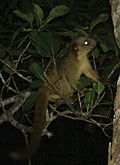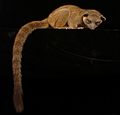Bassaricyon
| Bassaricyon | |
|---|---|
 | |
| Northern olingo (Bassaricyon gabbii) | |
| Scientific classification | |
| Domain: | Eukaryota |
| Kingdom: | Animalia |
| Phylum: | Chordata |
| Class: | Mammalia |
| Order: | Carnivora |
| Family: | Procyonidae |
| Subfamily: | Potosinae |
| Genus: | Bassaricyon Allen, 1876 |
| Type species | |
| Bassaricyon gabbii | |
| Species | |
| |
The genus Bassaricyon consists of small Neotropical procyonids, popularly known as olingos (/ɒˈlɪŋɡoʊz/), cousins of the raccoon. They are native to the rainforests of Central and South America from Nicaragua to Peru.[1] They are arboreal and nocturnal, and live at elevations from sea level to 2,750 m (9,020 ft).[2] Olingos closely resemble another procyonid, the kinkajou, in morphology and habits, though they lack prehensile tails and extrudable tongues, have more extended muzzles, and possess anal scent glands. However, the two genera are not sisters.[3] They also resemble galagos and certain lemurs.
Species
There is disagreement on the number of species in this genus, with some taxonomists splitting the populations into as many as five species (adding B. pauli to the list below), two species (dropping B. medius and B. neblina), or just a single species (B. gabbi).[4] Until recently, only the northern olingo (B. gabbii) was particularly well-known, and it was usually confusingly referred to simply as an olingo. Olingos are quite rare in zoos and are often misidentified as kinkajous.
A previously unrecognized olingo, similar to but distinct from B. alleni, was discovered in 2006 by Kristofer Helgen at Las Maquinas in the Andes of Ecuador.[5] He named this species B. neblina or olinguito and presented his findings on August 15, 2013.[6]
With data derived from anatomy, morphometrics, nuclear and mitochondrial DNA, field observations, and geographic range modeling, Helgen and coworkers demonstrated that four olingo species can be recognized:[2]
| Image | Scientific name | Common Name | Distribution |
|---|---|---|---|
 | Bassaricyon alleni | Eastern lowland olingo | Lowlands of Guyana, Venezuela, and in Colombia, Ecuador, Peru and Bolivia east of the Andes |
 | Bassaricyon gabbii | Northern olingo | Central American, lowlands and highlands of Nicaragua, Costa Rica, and western Panama |
 | Bassaricyon medius | Western lowland olingo | Lowlands of Panama and in Colombia and Ecuador west of the Andes |
 | Bassaricyon neblina | Olinguito | A montane species endemic to cloud forests in the Andes of Colombia and Ecuador[2] |
Evolution
Genetic studies have shown that the closest relatives of the olingos are actually the coatis;[2][3] the divergence between the two groups is estimated to have occurred about 10.2 million years (Ma) ago during the Tortonian age,[2] while kinkajous split off from the other extant procyonids about 22.6 Ma ago during the Aquitanian age.[7] The similarities between kinkajous and olingos are thus an example of parallel evolution.
The diversification of the genus apparently started about 3.5 million years ago, when B. neblina branched off from the others; B. gabbii then split off about 1.8 Ma ago, and the two lowland species, B. alleni and B. medius, diverged about 1.3 Ma ago.[2] The dating and biogeography modeling suggest that the earliest diversification of the genus took place in northwestern South America shortly after the ancestors of olingos first invaded the continent from Central America as part of the Great American Interchange.[2] The evolution of olingos thus contrasts with that of kinkajous, a much older lineage that is thought to have arisen in Central America long before they reached South America.[3]
| Bassaricyon |
| ||||||
References
- ^ Wozencraft, W. C. (2005). "Order Carnivora". In Wilson, D. E.; Reeder, D. M. (eds.). Mammal Species of the World: A Taxonomic and Geographic Reference (3rd ed.). Johns Hopkins University Press. ISBN 978-0-8018-8221-0. OCLC 62265494.
- ^ a b c d e f g Helgen, K. M.; Pinto, M.; Kays, R.; Helgen, L.; Tsuchiya, M.; Quinn, A.; Wilson, D.; Maldonado, J. (2013-08-15). "Taxonomic revision of the olingos (Bassaricyon), with description of a new species, the Olinguito". ZooKeys (324): 1–83. doi:10.3897/zookeys.324.5827. PMC 3760134. PMID 24003317.
- ^ a b c Koepfli, K.-P.; Gompper, M.E.; Eizirik, E.; Ho, C.-C.; Linden, L.; Maldonado, J.E.; Wayne, R.K. (2007). "Phylogeny of the Procyonidae (Mammalia: Carvnivora): Molecules, morphology and the Great American Interchange". Molecular Phylogenetics and Evolution. 43 (3): 1076–1095. CiteSeerX 10.1.1.495.2618. doi:10.1016/j.ympev.2006.10.003. PMID 17174109.
- ^ "The IUCN Red List of Threatened Species". IUCN Red List of Threatened Species. Retrieved 2018-10-27.
- ^ Handbook of the Mammals of the World (2009). ISBN 978-84-96553-49-1
- ^ Stromberg, Joseph (August 15, 2013). "For the First Time in 35 Years, A New Carnivorous Mammal Species is Discovered in the American Continents". Smithsonian Magazine. Archived from the original on August 30, 2013. Retrieved August 15, 2013.
- ^ Eizirik, E.; Murphy, W. J.; Koepfli, K.-P.; Johnson, W. E.; Dragoo, J. W.; Wayne, R. K.; O’Brien, S. J. (2010-02-04). "Pattern and timing of diversification of the mammalian order Carnivora inferred from multiple nuclear gene sequences". Molecular Phylogenetics and Evolution. 56 (1): 49–63. doi:10.1016/j.ympev.2010.01.033. PMC 7034395. PMID 20138220.
External links
 Data related to Bassaricyon at Wikispecies
Data related to Bassaricyon at Wikispecies Media related to Bassaricyon at Wikimedia Commons
Media related to Bassaricyon at Wikimedia Commons
- v
- t
- e
- Kingdom: Animalia
- Phylum: Chordata
- Class: Mammalia
- Order: Carnivora
- Suborder: Caniformia
| Procyon |
|
|---|---|
| Nasua |
|
| Nasuella |
|
| Bassariscus |
|
| Potos |
|
|---|---|
| Bassaricyon |
|












